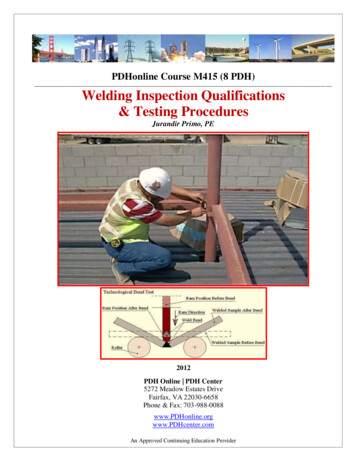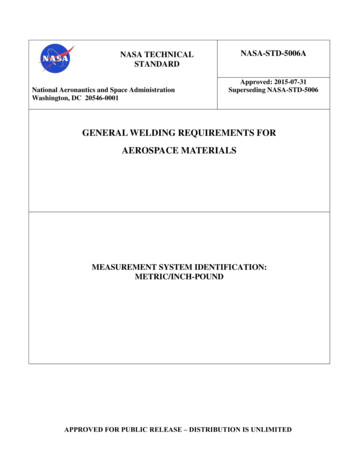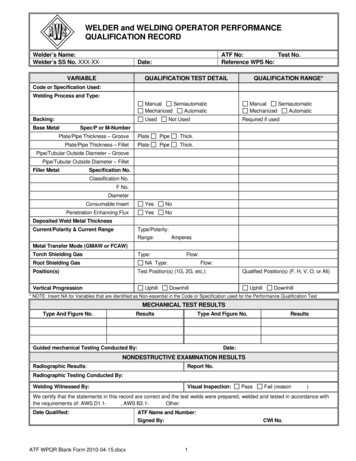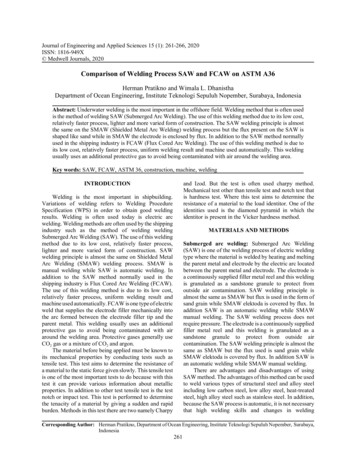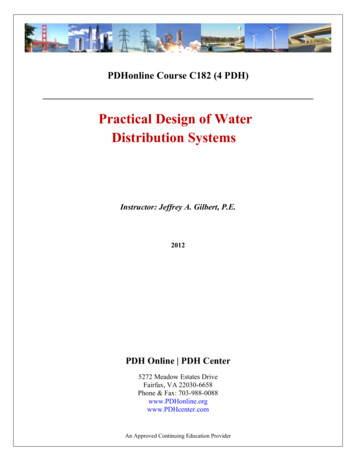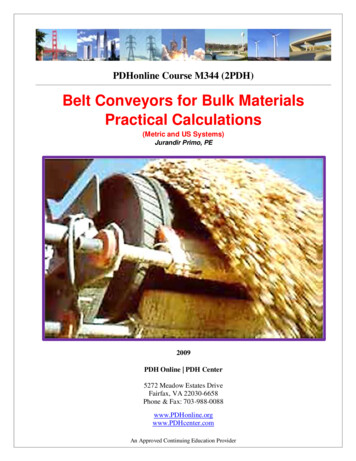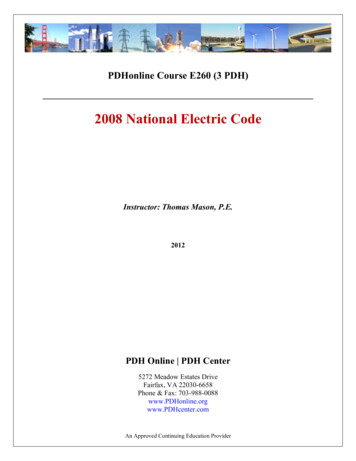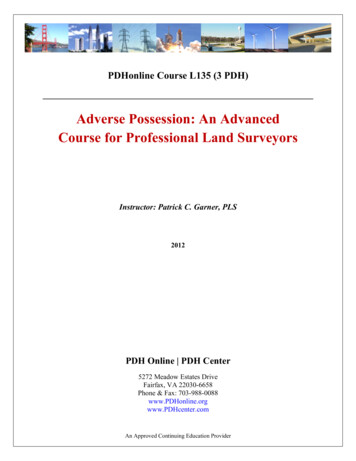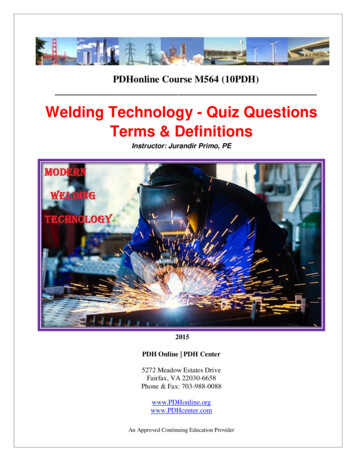
Transcription
PDHonline Course M564 (10PDH)Welding Technology - Quiz QuestionsTerms & DefinitionsInstructor: Jurandir Primo, PE2015PDH Online PDH Center5272 Meadow Estates DriveFairfax, VA 22030-6658Phone & Fax: 703-988-0088www.PDHonline.orgwww.PDHcenter.comAn Approved Continuing Education Provider
www.PDHcenter.comPDHonline Course M564www.PDHonline.orgWELDING TECHNOLOGY - QUIZ QUESTIONSTERMS & DEFINITIONSCONTENTS:PageI.INTRODUCTION2II.WELDING INSPECTOR CERTIFICATIONS3III.NDT CERTIFICATIONS4IV.WELDING TERMS AND DEFINITIONS6V.WELDING TECHNOLOGY – QUIZ QUESTIONS80 Module 1: Qualification, Inspection and Certification80 Module 2: Safety in Welding87 Module 3: Welding Processes, Cutting and Inspection Knowledge89 Module 4: Welding Metallurgy, NDT and Destructive Testing104 2015 Jurandir PrimoPage 1 of 121
www.PDHcenter.comI.PDHonline Course M564www.PDHonline.orgINTRODUCTION:Quiz questions are, undoubtedly, the best way to learn the concepts and definitions and to pass a testin any specific area. These quiz questions are based totally in several welding training courses andbrought here to help the students interested in advanced learning, even for specific areas. Thesequestions are commonly used on applicants to a job, operations, maintenance and in inspection, aspart of the global industry businesses. The answers are presented at the end of the quiz questions.A glossary, also known as a vocabulary, or clavis, is also presented with an alphabetical list of terms,considering the definitions for the most usual welding technology terms. Traditionally, a glossary appears at the end of a book and includes terms within that book, however, in this handbook the glossary is presented before each sector of the welding quiz questions, to show a guideline to students, thatenables definition of major concepts, especially for newcomers to this field of study.The welding industry is broad and includes people who carry the job title of "welders”, and others likepipe-fitters, boilermakers and iron-workers, who may weld, but only for a part of their day on the job.Beyond these skilled positions, there are technicians, inspectors, supervisors, managers and engineers, all involved with welding subjects, in some way or the other. The American Welding Society(AWS) are always credentialing professionals for all of these areas, from simple and informal insidecompanies’ trades, to nationally and internationally recognized programs.Testing in the welding industry is focused on the type of work being done. In some cases, typically forthe more basic level positions, there may be only a practical demonstration required. In other cases, awelding test may include a code or a practical hands-on including the fundamentals of the weldingsection in a written form, using multiple-choice questions with a time limit to complete the test. Once awelder is certified, he or she receives a written document, known as Welder Qualification Test Record(WQTR), which explains the extent to which the welder can work.Manufacturing, building structures, bridges, pressure vessels and storage tank codes require qualifiedwelders and inspectors. Then, companies must require certification of their welders, not only as marketing tools, but to ensure customers that the work is getting done correctly by competent people.Today, certifications are very important to help a newcomer or a professional to get his foot in theindustry door, at the interview stage. Properly qualified, one can rapidly advance through the ranks.To get your Professional Development Hours, this course includes a multiple-choice quiz at the end,based on the glossaries and consecutively in all questions concepts, defined to enhance the understanding of the course materials.PDHONLINE courses references:M381 - Welding Technology and Inspection Procedures – AWS D1.1M415 - Welding Inspection Qualifications & Testing ProceduresM514 - Gas Metal Arc Welding - GMAW – Best PracticesM544 - Underwater Welding Technology – Cutting & Inspection 2015 Jurandir PrimoPage 2 of 121
www.PDHcenter.comII.PDHonline Course M564www.PDHonline.orgWELDING INSPECTOR CERTIFICATIONS:The most common AWS professional certifications are:Certified Associate Welding Inspector (CAWI): To qualify as a Certified Associate Welding Inspector (CAWI), you must pass a vision test and have a combination of qualifying education and work experience, with supporting documentation.Minimum EducationHigh school diploma or hold a state or military approved high school equivalency diploma (e.g. GED)At least 8th gradeLess than 8th gradeAt least 8th grade with a minimum of one year of vocational education and training in awelding curriculum2 years post-high school education in a welding curriculum or engineering technology,engineering, or physical scienceWork Experience2 years4 years6 years3 years6 monthsCertified Welding Inspector (CWI): To qualify as a Certified Welding Inspector (CWI), you mustpass a vision test and have a combination of qualifying education and work experience, with supporting documentation:Minimum EducationAssociate or higher degree in engineering technology, engineering, or a physical scienceHigh school diploma plus two or more years engineering/technical school coursesHigh school diploma plus one year engineering/technical school courses or one or moreyears of vocational education and training in a welding curriculumHigh school diploma or approved high school equivalency diplomaAt least 8th gradeLess than 8th gradeWork Experience3 years3 years4 years5 years9 years12 yearsSenior Certified Welding Inspector (SCWI): Candidates typically will have supplemented their basiceducation or gained extensive problem-solving experience. This type of background generally provides them with a deeper and more specific understanding of advanced NDE topics, quality systems,procedure qualifications, and other SCWI knowledge areas as identified below:Must have a minimum of 15 years’ work experience;Direct relationship to welded assemblies fabricated to national or international standards;Direct involvement in two or more areas of welding inspection capabilities;Design - preparation of plans and drawing for weldments, preparation of inspection procedures, requirements, acceptance criteria;Production - planning, control, and supervision of welding materials and operations;Quality Control - detection and measurement of weld discontinuities, procedures, supervisionof personnel, specification of QC methods, review of QC programs of vendors;Examination - examination testing, visual or other nondestructive evaluation process;Repair of defective welds or supervision of personnel performing repair. 2015 Jurandir PrimoPage 3 of 121
www.PDHcenter.comPDHonline Course M564www.PDHonline.orgOther AWS Certifications: Certified Welding Educator; Certified Radiographic Interpreter; CertifiedWelding Supervisor; Certified Welding Sales Representative; Certified Welding Engineer; CertifiedWelder Certified Robotic Arc Welding.ExaminationPart A - Fundamentals(closed book test)Part B - Practical(hands on test)Part C - Code Book(open book test)Minimum no.of QuestionsDurationMinimum% to pass1502h72%462h72%46-602h72%* All Exam questions are multiple choices and objective typesNote: Effective March 16, 2015, all individuals who have applied for and are scheduled to test to theASME Sec IX: B31.1 & B31.3 codebook exam (Part C of CWI exam or CWI endorsement exam) willbe testing to the following editions; ASME Section IX: 2013; B31.1: 2014; B31.3: 2012.Certification Scheme for Personnel (CSWIP): The scope of CSWIP includes, Welding Inspectors,Welding Supervisors, Welding Instructors, Welding Examiners, Welding Quality Control Coordinators,Heat Treatment Operatives, Cathodic Inspection personnel, Plant Inspectors, Underwater Inspectors,Plastics Welders and NDT personnel, in accordance with BS EN ISO/IEC 17024.These certificates are normally accepted by all employers, though some European companies do notaccept AWS-CWI and some American companies do not accept CSWIP certificates, but these companies are just few. The Welding Inspector’s Certificates offered by TWI-UK (www.twisea.com) are:3.0 Visual Welding Inspector;3.1 Welding Inspector;3.2.1 Senior Welding Inspector) without radiographic interpretation;3.2.2 Senior Welding Inspector with radiographic interpretation.Obs.: Effective May 21, 2012, individuals holding CSWIP credentials must fill out all standard applications to register for CWI examinations, and must take and pass all three components of the CWI examination to earn CWI credentials.III.NDT CERTIFICATION:ASNT Certification: The ASNT NDT Level II certification program was developed to provide standardLevel II written examinations to satisfy the general and specific examination guidelines of recommended Practice No. SNT-TC-1A.General Examinations: There are 50 questions multiple-choice general examinations that cover thefundamentals, principles and theory found in the ANSI/ASNT American National Standard CP105, ASNT Standard Topical Outlines for Qualification of Nondestructive Testing Personnel. 2015 Jurandir PrimoPage 4 of 121
www.PDHcenter.comPDHonline Course M564www.PDHonline.orgASNT NDT Level II: Qualification Requirements. Candidate shall agree to abide by the ASNT Level IICode of Ethics and must document the combination of education and experience as shown below:TrainingHoursExperienceHours in MethodTotal Hours in NDTLiquid Penetrant12210400Magnetic 401600Visual24210400Examination MethodSpecific Examinations: The specific examinations determine the industry Sector. ASNT currentlyoffers Specific examinations for the General Inspection and Pressure Equipment Sectors. These examinations consist of 40 multiple-choice questions based on an NDT procedure covering the equipment, operating processes and NDT techniques commonly used in the applicable industry Sector.Examination TimesTest MethodExamination TypeMTPTRTUTVTGeneral2 hours2hours2hours2hours2 hoursSpecific2 hours2hours2hours2hours2 hoursThe ASNT NDT Level III Program and the Industrial Radiography and Radiation Safety Personnel(IRRSP) program are accredited by ANSI to ISO/IEC 17024:2003. General requirements for bodiesoperating certification of persons. There are four ASNT certification programs:ASNT NDT Level III Program,ASNT Central Certification Program (ACCP),ASNT NDT Level II program, andIndustrial Radiography and Radiation Safety Personnel (IRRSP) program.Basic and Method Exams: ASNT NDT Level III certification candidates are required to pass both theNDT Basic and a method examination in order to receive the ASNT NDT Level III certificate. For thefull topical outlines and complete list of references, see the topical outlines listed in the American National Standard ANSI/ASNT CP-105, Standard Topical Outlines for Qualification of NondestructiveTesting Personnel. 2015 Jurandir PrimoPage 5 of 121
www.PDHcenter.comIV.PDHonline Course M564www.PDHonline.orgWELDING TERMS AND DEFINITIONS:Welding Positions Standards: Welding is usually easiest when the welder can work on a joint located on a flat, horizontal surface, such as on a table or bench. However, joints in the field may be located in a variety of positions relative to the welder and to the horizon. It is very important for a WeldingInspector to know the position, or location of a joint relative to the horizon, because it may determinewhat welding process, methods, and techniques are used.1F, pipe. A welding test position designation for a circumferential fillet weld applied to a joint in pipe,with its axis approximately 45 from horizontal, in which the weld is made in the flat welding positionby rotating the pipe about its axis. See figure below:1F, plate. A welding test position designation for a linear fillet weld applied to a joint in which the weldis madein the flat welding position. See figure below:1G, pipe. A welding test position designation for a circumferential groove weld applied to a joint inpipe, in which the weld is made in the flat welding position by rotating the pipe about its axis. See figure below:1G, plate. A welding test position designation for a linear groove weld applied to a joint, in which theweld is made in the flat welding position. See figure below:2F, pipe. A welding test position designation for a circumferential fillet weld applied to a joint in pipe,with its axis approximately vertical, in which the weld is made in the horizontal welding position. Seefigure below:2F, plate. A welding test position designation for a linear fillet weld applied to a joint, in which the weldis made in the horizontal welding position. See figure below: 2015 Jurandir PrimoPage 6 of 121
www.PDHcenter.comPDHonline Course M564www.PDHonline.org2FR, pipe. A welding test position designation for a circumferential fillet weld applied to a joint in pipe,with its axis approximately horizontal, in which the weld is made in the horizontal welding position byrotating the pipe about its axis. See figure below:2G, pipe. A welding test position designation for a circumferential groove weld applied to a joint in apipe, with its axis approximately vertical, in which the weld is made in the horizontal welding position.See figure below:2G, plate. A welding test position designation for a linear groove weld applied to a joint in which theweld is made in the horizontal welding position. See figure below:3F, plate. A welding test position designation for a linear fillet weld applied to a joint in which the weldis made in the vertical welding position. See figure below:3G, plate. A welding test position designation for a linear groove weld applied to a joint in which theweld is made in the vertical welding position. See figure below:4F, pipe. A welding test position designation for a circumferential fillet weld applied to a joint in pipe,with its axis vertical, in which the weld is made in the overhead welding position. See figure below:4F, plate. A welding test position designation for a linear fillet weld applied to a joint, in which the weldis made in the overhead welding position. See figure below:4G, plate. A welding test position designation for a linear groove weld applied to a joint in which theweld is made in the overhead welding position. See figure below:5F, pipe. A welding test position designation for a circumferential fillet weld applied to a joint, in pipe,with its axis approximately horizontal, in which the weld is made in the horizontal, vertical, and overhead welding positions. The pipe remains fixed until the welding of the joint is complete. See figurebelow:5G, pipe. A welding test position designation for a circumferential groove weld applied to a joint in apipe with its axis horizontal, in which the weld is made in the flat, vertical, and overhead welding positions. The pipe remains fixed until the welding of the joint is complete. See figure below:6F, pipe. A welding test position designation for a circumferential fillet weld applied to a joint in pipe,with its axis approximately 45 from horizontal, in which the weld is made in flat, vertical, and overhead welding positions. The pipe remains fixed until welding is complete. See figure below:6G, pipe. A welding test position designation for a circumferential groove weld applied to a joint inpipe, with its axis approximately 45 from horizontal, in which the weld is made in the flat, vertical, andoverhead welding positions. The pipe remains fixed until welding is complete. See figure below:6GR, pipe. A welding test position designation for a circumferential groove weld applied to a joint inpipe, with its axis approximately 45 from horizontal, in which the weld is made in the flat, vertical, and 2015 Jurandir PrimoPage 7 of 121
www.PDHcenter.comPDHonline Course M564www.PDHonline.orgoverhead welding positions. A restriction ring is added, adjacent to the joint, to restrict access to theweld. The pipe remains fixed until welding is complete. See figure below:Welding certifications come in many position depending on the type of structure that will be welded.Most codes allow a welder to take a combination of the 3 and 4G positions. However, fillet welds donot qualify the welder for groove welds. The code system in ASME IX QW-461.1 and QW-461.2 is:1 - stands for the flat position (F)2 - stands for the horizontal position (H)3 - stands for the vertical position (V)4 - stands for the overhead position (O)F - stands for a filler weld jointG - stands for a groove weld joint.Pipe welding test positions have the same coding system as structural positions with one main exception, the “R” or restricted position, to make the test as difficult as possible to provide the same types ofobstacles that the welder will encounter in the field. For example a 6GR test would be a pipe in thefixed 45º position with a restricted groove joint. 2015 Jurandir PrimoPage 8 of 121
www.PDHcenter.com 2015 Jurandir PrimoPDHonline Course M564www.PDHonline.orgPage 9 of 121
www.PDHcenter.comPDHonline Course M564www.PDHonline.orgGlossary: Welding terms and definitions according to AWS A3.0M/A3.0:2010. Including terms forAdhesive Bonding, Brazing, Soldering, Thermal Cutting, and Thermal Spraying.AAbrasion soldering. A soldering process variation during which surface wetting is enhanced byabrading the faying surfaces.Abrasive blasting. A method of cleaning or surface roughening by a forcibly projected stream ofabrasive particles.Acetylene feather. The intense white, feathery-edged portion adjacent to the cone of a carburizingoxyacetylene flame.Acid core solder. A solder wire or bar containing acid flux as a core.Activated rosin flux. A rosin-based flux containing an additive that increases wetting by the solder.Adaptive control process. An operation with a control system sensing changes in conditions andautomatically directing the equipment to take appropriate action. See adaptive control brazing, adaptive control soldering, adaptive control thermal cutting, adaptive control thermal spraying, and adaptive control welding. Adaptive control soldering (S-AD); Adaptive control thermal cutting (TC-AD).Adaptive control thermal spraying (TS-AD).Agglomerated flux. A granular flux produced by baking a pelletized mixture of powdered ingredientsand bonding agents at a temperature sufficient to remove the water, followed by processing to produce the desired particle size (submerged arc welding). See also bonded flux and fused flux.Air Acetylene Welding (AAW). An oxyfuel gas welding process using an air-acetylene flame. Theprocess is used without the application of pressure. This is an obsolete or seldom used process.Air Carbon Arc Cutting (CAC-A). A carbon arc cutting process variation removing molten metal witha jet of air.Air carbon arc cutting torch. A device used to transfer current to a fixed cutting electrode, positionthe electrode, and direct the flow of air.Air feed. A thermal spraying process variation in which an air stream carries the powdered surfacingmaterial through the gun and into the heat source. 2015 Jurandir PrimoPage 10 of 121
www.PDHcenter.comPDHonline Course M564www.PDHonline.orgAligned discontinuities. Three or more discontinuities aligned approximately parallel to the weldaxis, spaced sufficiently close together to be considered a single intermittent discontinuity.Aligned porosity. A localized array of porosity oriented in a line.Alloy. A substance with metallic properties and composed of two or more chemical elements of whichat least one is a metal.Alloy flux. A flux containing ingredients reacting with the filler metal to establish desired alloy contentin the weld metal (submerged arc welding). Active flux. A flux formulated to produce a weld metalcomposition dependent on the welding parameters, especially arc voltage (submerged arc welding).Alloy powder. Powder prepared from a homogeneous molten alloy or from the solidification productof such an alloy. See also powder blend.Arc blow. The deflection of an arc from its normal path due to magnetic forces.Arc Braze Welding (ABW). A braze welding process variation using an electric arc as the heatsource. See also carbon arc braze welding.Arc Cutting (AC). A group of thermal cutting processes severing or removing metal by melting withthe heat of an arc between an electrode and the workpiece.Arc cutting gun. A device used to transfer current to a continuously fed cutting electrode, guide theelectrode, and direct the shielding gas. Arc cutting torch. See air carbon arc cutting torch, gas tungsten arc cutting torch, and plasma arc cutting torch.Arc gouging. Thermal gouging using an arc cutting process variation to form a bevel or groove.Arc length. The distance from the tip of the electrode to the adjacent surface of the weld pool.Arc plasma. A gas heated by an arc to at least a partially ionized condition, enabling it to conduct anelectric current.Arc seam weld. A seam weld made by an arc welding process. 2015 Jurandir PrimoPage 11 of 121
www.PDHcenter.comPDHonline Course M564www.PDHonline.orgArc Spraying (ASP). A thermal spraying process using an arc between two consumable electrodesof surfacing materials as a heat source and a compressed gas to atomize and propel the surfacingmaterial to the substrate.Arc strike. A discontinuity resulting from an arc, consisting of any localized melted metal, heataffected metal, or change in the surface profile of any metal object.Arc Stud Welding (SW). An arc welding process using an arc between a metal stud, or similar part,and the other workpiece. The process is used without filler metal, with or without shielding gas or flux,with or without partial shielding from a ceramic or graphite ferrule surrounding the stud, and with theapplication of pressure after the faying surfaces is sufficiently heated.Arc time. The time during which an arc is maintained in making an arc weld.Arc Welding (AW). A group of welding processes producing coalescence of workpieces by meltingthem with an arc. The processes are used with or without the application of pressure and with or without filler metal.Arc welding deposition efficiency. The ratio of the weight of filler metal deposited in the weld metalto the weight of filler metal melted, expressed in percent.Arc welding electrode. A component of the welding circuit through which current is conducted andthat terminates at the arc.Arc welding gun. A device used to transfer current to a continuously fed consumable electrode,guide the electrode, and direct the shielding gas. Arc welding torch. A device used to transfer currentto a fixed welding electrode, position the electrode, and direct the shielding gas.Assembly. One or more components, members, or parts fit in preparation for joining.Assist gas. A gas used to blow molten metal away to form the kerf in laser beam inert gas cutting, orto blow vaporized metal away from the beam path in laser beam evaporative cutting. 2015 Jurandir PrimoPage 12 of 121
www.PDHcenter.comPDHonline Course M564www.PDHonline.orgAtomic Hydrogen Welding (AHW). An arc welding process using an arc between two metal electrodes in a shielding atmosphere of hydrogen and without the application of pressure. This is an obsolete or seldom used process.Autogenous weld. A fusion weld made without filler metal.Automatic arc welding current. The current in the welding circuit during the making of a weld, butexcluding upslope, downslope, and crater fill current. Automatic arc welding downslope time. The timeduring which the current is changed continuously from final taper current or welding current to finalcurrent. Automatic arc welding upslope time. The time during which the current changes continuouslyfrom the initial current to the welding current.Automatic process. An operation performed with equipment requiring occasional or no observationand no manual adjustment during its operation. See automatic brazing, automatic soldering, automatic thermal cutting, automatic thermal spraying, and automatic welding, automatic soldering (S-AU),automatic thermal cutting (TC-AU), automatic thermal spraying (TS-AU), automatic welding (W-AU).Automatic process arm. A beam extending from the frame of a resistance welding machine totransmit electrode force and sometimes conduct welding current.Auxiliary magnifier. An additional lens used to magnify the field of vision.BBack bead. A weld bead resulting from a back weld pass. 2015 Jurandir PrimoPage 13 of 121
www.PDHcenter.comPDHonline Course M564www.PDHonline.orgBack cap. A device used to exert pressure on the collet in a gas tungsten arc welding torch and create a seal to prevent air from entering the back of the torch.Back weld. A weld made at the back of a single groove weld.Backfire. The momentary recession of the flame into the torch, potentially causing a flashback orsustained backfire. It is usually signaled by a popping sound, after which the flame may either extinguish or reignite at the end of the tip. See also flashback and sustained backfire.Back-gouging. The removal of weld metal and base metal from the weld root side of a welded joint tofacilitate complete fusion and complete joint penetration upon subsequent welding from that side.Backhand welding. A welding technique in which the welding torch or gun is directed opposite to theprogress of welding. See drag angle, forehand welding, push angle, travel angle, and work angle.Backing. A material or device placed against the back side of the joint adjacent to the joint root, or atboth sides of a joint in electroslag and electrogas welding, to support and shield molten weld metal.The material may be partially fused or remain unfused during welding and may be either metal ornonmetal. 2015 Jurandir PrimoPage 14 of 121
www.PDHcenter.comPDHonline Course M564www.PDHonline.orgBacking gas. Backing in the form of a shielding gas employed primarily to provide a protective atmosphere.Backing ring. Backing in the form of a ring, generally used in the welding of pipe.Backing shoe. A barrier device used in electroslag and electrogas welding to contain the weld without being fused. See also moving shoe and stationary shoe.Backstep sequence. A longitudinal sequence in which weld passes are made in the direction opposite to the progress of welding. 2015 Jurandir PrimoPage 15 of 121
www.PDHcenter.comPDHonline Course M564www.PDHonline.orgBackup. A locating device used to transmit all or a portion of the upset force to the workpieces or toaid in preventing the workpieces from slipping during upsetting. Backup electrode. An electrode having a large electrode face opposing the welding force.Balling up. The formation of globules of molten filler metal or flux due to insufficient base metal wetting (brazing and soldering).Bare electrode. A filler metal electrode produced as a wire, strip, or bar with no coating or coveringexcept one incidental to its manufacture or preservation.Bare Metal Arc Welding (BMAW). An arc welding process using an arc between a bare or lightlycoated electrode and the weld pool. The process is used without shielding, without the application ofpressure, and filler metal is obtained from the electrode. This is an obsolete or seldom used process.Base metal. The metal or alloy being welded, brazed, soldered, or cut. See base material and substrate. Base metal test specimen. A test specimen composed wholly of base metal.Base Metal Zone (BMZ). The portion of base metal adjacent to a weld, braze or solder joint or thermal cut and unaffected by welding, brazing, soldering, or thermal cutting. See heat-affected zone andweld metal zone.Beam divergence. The expansion of a beam’s cross section as the beam emanates from its source. 2015 Jurandir PrimoPage 16 of 121
www.PDHcenter.comPDHonline Course M564www.PDHonline.orgBend test. A test in which a specimen is bent to a specified bend radius. See face bend test, rootbend test, and side bend test.Berry formation. A nonstandard term for nozzle accumulation.Bevel angle. The angle between the bevel of a joint member and a plane perpendicular to the surface of the member. Bevel edge shape. A type of edge shape in which the prepared surface or surfaces lies at some angle other than perpendicular to the material surface. Bevel radius. The radiusused to form a J-edge shape.Bevel face. The prepared surface of a bevel edge shape. Bevel-groove weld. A type of groove weld.Bit. Part of the soldering iron, usually made of copper, provided to directly transfer heat, and sometimes soldering filler metal, to the joint. 2015 Jurandir PrimoPage 17 of 121
www.PDHcenter.comPDHonline Course M564www.PDHonline.orgBlacksmith welding. A nonstandard term when used for forge welding.Blanket brazing. A brazing process variation employing a flexible, resistance-heated blanket(s) asthe heat source.Blind joint. A joint, no portion of which is visible.Block brazing (BB). A brazing process employing heated blocks as the heat source. This is an obsolete or seldom used process.Block sequence. A combined longitudinal and cross-sectional sequence for a continuous multiplepass weld in which separated segments are completely or partially welded before intervening segments are welded. See also cascade sequence, cross-sectional sequence, progressive block sequence, and selective block sequence.Blowhole. A nonstandard term when used for porosity.Bond. See covalent bond, ionic bond, mechanical bond, and metallic bond, bond cap, bond bar,(nonstandard term for bond specimen).Bonded flux. A granular flux produced by baking a pelletized mixture of powdered ingredients andbonding agents at a temperature below its melting point, but high enough to create a chemical bond,followed by processing to produce the desired particle size. See agglomerated flux and fused flux.Bond line. The cross section of the interface between a thermal spray deposit and the substrate.Bond coat. A preliminary (or prime) coat of m
V. WELDING TECHNOLOGY – QUIZ QUESTIONS Module 1: Qualification, Inspection and Certification Module 2: Safety in Welding Module 3: Welding Processes, Cutting and Inspection Knowledge Module 4: Welding


